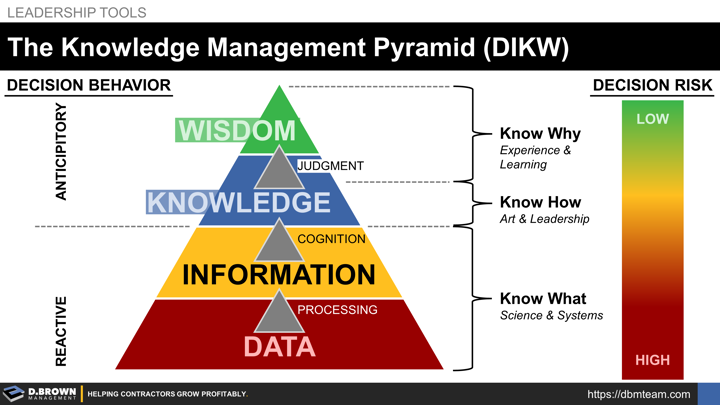One of these is called the DIKW Pyramid for:
- Data: Simply signals and other inputs.
- Information: Data that has been organized into a useful format.
- Knowledge: Information put in context.
- Wisdom: Knowledge turned into decisions and action.
It all starts with Data Collection, especially important is knowing what data to collect which starts with knowing what types of decisions must be made.
- Data is Processed to become Information.
- Information is analyzed and interpreted to become knowledge - cognition.
- Knowledge is used to apply judgment and make good decisions - wisdom.
It's important to note that sometimes you don't fully know what it will look like when complete, so you start collecting and analyzing data, gradually defining the usage better. This must be done from a higher level, starting with people at the wisdom level who already have a vast amount of knowledge about the area. See Stratified Systems Theory (SST) to learn more.
If you let this build from the ground up, the data collectors and analysts who transform it into metrics will create more and more. Without context and direction, this becomes expensive and useless at best, counter-productive to decision making at worst.
Between the Information and Knowledge layers of the pyramid, the decision making starts to change from more reactive to more anticipatory. A closely related concept is "Situational Awareness" levels of Perception, Comprehension, and Projection.
Related to the Why, How, then What diagram of communication that Simon Sinek describes, the capabilities build from the ground up:
- Knowing What - The Science and Systems of Data and Information
- Knowing How - The Art and the Leadership
- Knowing Why - Experience and Learning
As you navigate your career, you will grow through each of these stages of knowledge from data through wisdom. As you help others develop, remember that they need to learn and build from the ground up. As you get nearer the top, you must architect and communicate from the top down.
Think about your best project team members, including conceptual estimators who are great at the preconstruction stage. They have phenomenal abilities to take a wide range of data and turn it into a complex 5D model of the project in their heads that they make great decisions from.
You can back up to a much broader world view, looking at trends for 200 countries over the last 200 years summarized brilliantly by Hans Rosling in four minutes.
Book Factfulness
Whether you are leading a construction company or looking at the broader world, you can see where focusing only on data and information without broader context is reactive and leads to increased decision risk.
We are collecting more data points than ever, and our communication systems now give us dozens of channels of communication that are all nearly instantaneous. Remember that more data points including communication does not make something more or less true , but it does shift our confidence level which is dangerous.
If more data translated directly to results, the US population would be in dramatically better health given the myriad of wearables and websites dedicated to quantifying health stats. Construction is no different.
Consider this pyramid as you make your strategic market choices and build those into your opportunity evaluation process. This is the biggest lever you have in growing your business profitably while mitigating risks and keeping stress levels of the team manageable.

